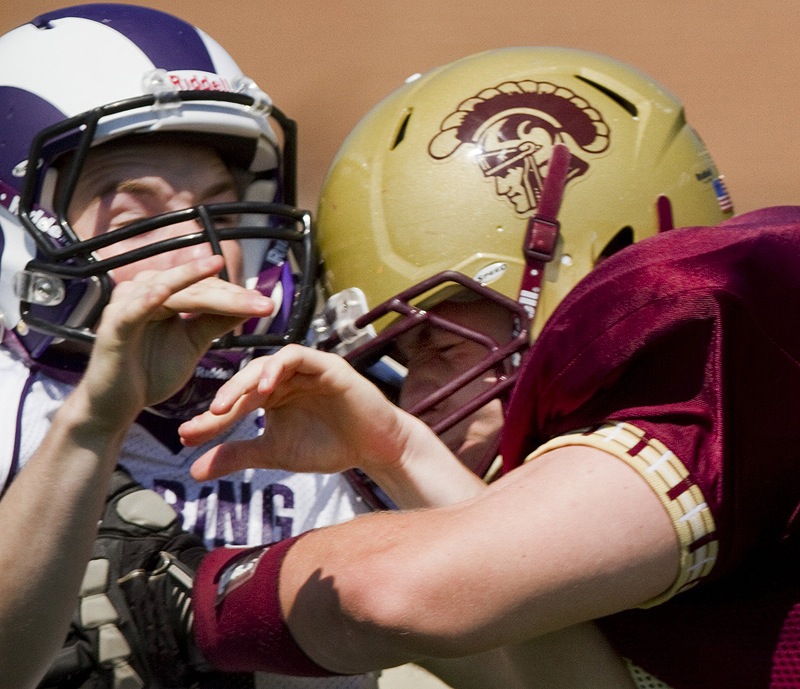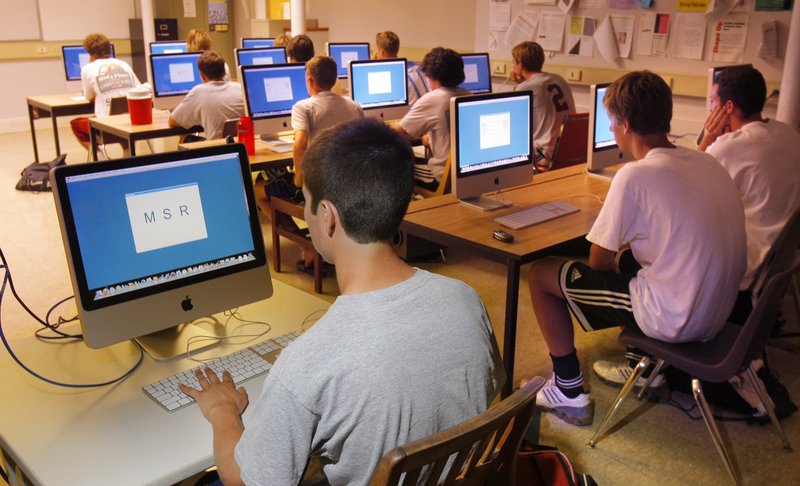PORTLAND – For several years, high schools in Maine have used tests based on cognitive thinking to determine when student-athletes who suffer concussions are ready to return to competition. Now, athletes at Deering High will have to prove they’re also physically ready to return.
Deering is part of a pilot program that’s designed to create a second baseline score for concussion treatment, and to screen athletes for potential knee injuries.
“Now we’ll have two tests,” said Mel Craig, the athletic director at Deering. “It’s new and it’s different and it’s just another way to keep our kids safe.”
Schools in Maine have used the ImPact test for several years to determine when a player can return from a concussion. Deering is incorporating the OptoJump system to provide a second opinion.
Craig said any Deering athlete who suffers a concussion will have to pass both tests before returning to competition or practice.
“We’re getting a more complete picture of where the athlete is at, post-concussion,” she said. “We’ll feel much more comfortable.”
Concussions have been in the national spotlight for several years, prompted by several suicides involving retired NFL players who suffered head injuries during their careers, including former New England Patriot Junior Seau. The NFL is now being sued by more than 80 former players over head injuries.
Forty-eight states and the District of Columbia have passed laws to establish guidelines for the evaluation and treatment of concussions among high school athletes, according to NFL.com. Maine’s law, effective Jan. 1, will require schools to establish protocols to diagnose and treat concussions, including having “a licensed health care provider trained in concussion management.”
Craig believes Deering is the first school in Maine to use the OptoJump test. The school’s booster club paid the $1,000 fee to test the football and girls’ soccer teams — the two teams most prone to concussions and knee injuries.
OptoJump measures the symmetry of each step — how long it takes between steps, how long the athlete lands on one foot or the other — and picks up any misalignments in the gait, hips or neck that could lead to injuries.
Craig said that enables the school to institute preventive exercises, to reduce the risk of ligament injuries or help plan rehab if an injury occurs.
“We can come up with a treatment plan for each individual player,” she said.
The OptoJump test is used at the U.S. Olympic Training Center, at the Nike training center and at many colleges — Northeastern University in Boston has been using it for the last six years.
The biggest difference between the ImPact test and OptoJump is how the baseline is created. The ImPact test is taken on a computer screen to determine a student’s cognitive responses. The OptoJump test involves physical movement.
A student stands between two metal rods — called skis, each 1 meter long — and, while marching, is asked to do seven functions: look straight ahead; look to the right; look to the left; look overhead; calculate simple math problems; close the eyes; close the eyes and cover the ears.
Their gait is recorded by 96 LED lights and two video cameras, providing a baseline graph for each step. The tasks provide a baseline score for concussions.
The student is also asked to jump and make other athletic moves, to help determine susceptibility to an anterior cruciate ligament injury.
“We call it a dynamic movement, or a dynamic testing,” said Dr. Kevin Bardwell, a chiropractor in Yarmouth and former Deering High teacher who approached Craig about starting a pilot program. “The goal is to get the kids to practice an athletic movement, test them against a baseline and see if they’re ready to go back to play.”
In no way is OptoJump designed to replace ImPact testing, said Bardwell and Craig.
Bardwell noted that ImPact testing “would not pick up the subtle, physical, biomechanical differences (caused by a head injury). This does.”
“What it comes down to is that we’re measuring balancing and symmetry,” he said, “how, after the hit to the head, how’s their balance, how’s their symmetry. But if we don’t have baselines, we have nothing to compare it to.”
Bardwell said some “weird stuff” has already been discovered.
Some students, when told to close their eyes, march in a tight circle. That would be their baseline and they would have to repeat that before returning from a concussion.
Dan Boothby, the strength and conditioning coach at Northeastern, said the university still uses the ImPact test as the baseline for athletes to return from concussions, while the OptoJump test provides valuable data to keep athletes safe all year.
“It allows us to collect in-depth data quickly and to see what changes in movement patterns the athletes are having over the course of a season, over the off-season,” said Boothby, a 2000 graduate of Kennebunk High.
That’s another thing that Deering officials like. The Rams suffered four ACL tears in football last year. They want to prevent a repeat, if possible.
Craig said the Rams are working with Bwellhealth (where Bardwell has his practice) and Port City Physical Therapy to come up with the program.
Scott Parsons, the first-year football coach at Deering, calls it “revolutionary stuff.”
He is using data from the testing to format the team’s conditioning programs and practice plans, “to be proactive on keeping these guys’ knees in check,” he said.
Mike Lowe can be contacted at 791-6422 or at:
mlowe@pressherald.com
Twitter: MikeLowePPH
Copy the Story Link
Send questions/comments to the editors.





Success. Please wait for the page to reload. If the page does not reload within 5 seconds, please refresh the page.
Enter your email and password to access comments.
Hi, to comment on stories you must . This profile is in addition to your subscription and website login.
Already have a commenting profile? .
Invalid username/password.
Please check your email to confirm and complete your registration.
Only subscribers are eligible to post comments. Please subscribe or login first for digital access. Here’s why.
Use the form below to reset your password. When you've submitted your account email, we will send an email with a reset code.